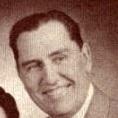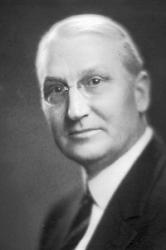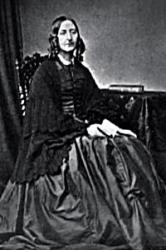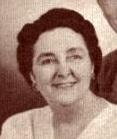Planning worship?
Check out our sister site, ZeteoSearch.org,
for 20+ additional resources related to your search.
- |
User Links
Person Results
George F. Root

1820 - 1895 Meter: 11.9.11.9 with refrain Composer of "RING THE BELLS" in Baptist Hymnal 1991 Root, George F., MUS. DOC, born in Sheffield, Berkshire County, Mass., Aug. 30, 1820. He is much more widely known as a composer of popular music than as a hymn writer. Four of his hymns are in I. D. Sankey's Sacred Songs & Solos, 1878. Nos. 16, 100, 293, and 297. A sympathetic biographical sketch, with portrait, is in The Tonic Sol-Fa Reporter, Sep. 1886. He died Aug. 6, 1895.
--John Julian, Dictionary of Hymnology, Appendix, Part II (1907)
=====================
George Frederick Root was born in Sheffield, Mass., August 30, 1820. His father moved to North Reading, near Boston, when the boy was six years old, and there his youth was spent.
He was always fond of music— not singing at all as a boy, but played upon every kind of instrument that came in his way. At thirteen it was his pride that he could "play a tune" on as many instruments as he was years old. His dream of life was to be a musician, although such an ambition was looked down upon by all his relatives and friends, excepting a fond mother. In the fall of 1838 he went to Boston and made an engagement to work for Mr. A. N. Johnson and take lessons on the piano.
His father and one of the brothers were at the time in South America, and the mother, with six younger children, was at home on the farm. When he secured the engagement with Mr. Johnson to receive three dollars a week and board and lessons, the neighbors became interested and encouraged him to go ahead, they promising to help look after the farm and see that the family got along. The young man's happiness over these events can better be imagined than described.
On the second day of October, 1838, he entered upon his duties in his new heaven on earth located at Harmony Hall, Mr. Johnson's music-room, in Boston. His duties were to see to the fires, care for the room, answer callers, give information about Mr. Johnson when he was out, and practice his lessons when not otherwise engaged. He worked industriously and made steady progress. It was but a few weeks till Mr. Johnson had him playing for the prayer-meeting, and but a few more till he began turning over pupils to him. In about seven weeks' time Mr. Johnson encouraged him by a considerable increase of salary. A most important event to him was meeting Dr. Lowell Mason and being accepted as a bass singer in the celebrated Bowdoin Street choir. Also, on Mr. Johnson's recommendation, he began taking private voice lessons of Mr. Geo. Jas. Webb, the then celebrated voice teacher of Boston. He continued at least a year with Mr. Webb.
His first real singing class was taught the following fall, 1839, at the North End. It lasted nearly through the winter, and on the closing night his class made him a present of a silver goblet, suitably engraved, which he kept among his treasures.
Before the first year was up Mr. Johnson proposed a five year partnership, by which Mr. Root was to receive one-third of their earnings, and the former was to have the privilege of visiting Germany part of the time if he chose. They then changed their quarters to three rooms in the basement of Park Street Church. The annual rental was six hundred dollars. They were kept quite busy.
At this time Dr. Mason's music teaching in the public schools was a growing success, and Messrs. Johnson and Root were employed to assist him. Drs. Mason and Webb had introduced what is now called Musical Conventions a year or two previous to this. They called them "The Teachers' Class." Teachers and singers were called to Boston from surrounding territory to study and practice pretty much as they do now at normals.
In 1841 Mr. Root became one of the teachers in this class. He taught vocal training and continued this work for years afterward in Dr. Mason's teachers' classes, and later incorporated the same method in his own normals. During this year Mr. Johnson went to Germany, and left the two large church choirs (Winter Street and Park Street) in charge of Mr. Root. One of the organs was played by a pupil — Mr. S. A. Bancroft.
Everything went smoothly during Mr. Johnson's absence as it did also after his return. During the last year of the five-year partnership, Mr. Root was called to take the organ at Bowdoin Street, Mr. Mason changing to Winter Street. An amicable settlement was made between Messrs. Johnson and Root, and the partnership dissolved.
In 1811, Mr. Jacob Abbott (father of Lyman Abbott)and his three brothers had established a young ladies' school in New York City. They wanted a music teacher, and offered the position to Mr. Root. They also secured him the organ and choir of the Mercer Street Church, with prospects for other good work. It required pretty strong persuasive arguments to tempt Mr. Root to leave Boston, he was doing well there, and as the sequel shows, there was an attraction in Boston that held him in too tight a grasp to be relinquished by the mere offer of greater power and place. He made up his mind, however, only after getting the consent of the powders of Boston to take with him this [to him] the greatest attraction of the city — Miss Mary Olive Woodman — an accomplished lady, a sweet singer, and a member of a prominent family of musicians. He went to New York first to prepare a home, and in August, 1845, returned for his bride, who took her place in his New York choir as leading soprano, and through his long and eventful career she was ever at his side, a true helpmeet.
He was soon employed at Rutger's Female Institute, Miss Haines' School for Young Ladies, Union Theological Seminary and the New York State Institution for the Blind. Within six weeks after he arrived in New York his time was fully occupied. He continued with Mr. Abbott's young ladies' school ten years.
While teaching in New York he continued his summer work with Messrs. Mason and Webb in Teachers' Classes. Up to the year 1849 he had written but little music; only a few hymn tunes while in Boston. He needed more music for the young ladies of his schools, so he made his first book, The Young Ladies' Choir, of which he had enough copies made for his own use, as he had no thought of offering it to the public. Then in connection with Mr. J. E. Sweetser, they compiled the Root and Sweetser's Collection.
Mr. Root did work enough for two men, hence broke down in health. Mr. Abbott suggested that he take a trip to Paris. After weighing the matter carefully, in December, 1853, he sailed, and in due time arrived at Paris, where he began studying French, voice culture and piano under celebrated teachers. After spending nearly a year abroad, he returned home in improved health and ready for active work. He began to feel the need of new music for his classes, and after some thought decided upon a musical play ; the subject and title, The Flower Queen.
At the Institution for the Blind was a young lady, a former pupil, but now a teacher who had shown some poetical talent. He asked her to help him with the words. He would suggest in prose what the flowers might say and she would put it into rhyme. She did it so well that it seldom needed any alteration. This lady was the now famous Fanny Crosby. The cantata became very popular. About this time Mr. Root wrote a half dozen simple songs for the people. They all sold pretty well, but Hazel Dell and Rosalie, the Prairie Flower, became the most popular, and had a large sale.
It was in the summer of 1853 that the first real normal was held. Mr. Root originated it, and held it in New York. The principal teachers were Messrs. Mason, Root, Hastings, and Bradbury. This school became famous. Sessions were also held at North Reading, Mass., a village near Mr. Root's "Willow Farm Home," with Dr. Mason, Mr. Webb, Mr. Bradbury and himself as principal teachers.
About this time Mr. Root decided to give up his work in New York, and devote himself entirely to conventions, normal work and authorship. He was eminently successful. Among the most eminent teachers and composers of our country have been students in Dr. Geo. F. Root's Normal Musical Institute.
In 1860 Dr. Root settled in Chicago and entered the music publishing business with his brother E. T. Root, and C. M. Cady, as "Root & Cady," Mr. Root's reputation being the most important capital of the firm. His books and popular songs soon made the new firm prosperous. Then came the war with its horror. Dr. Root wielded his musical sword in the way of writing war songs, which made him famous. The Battle Cry of Freedom, Just Before the Battle, Mother, and others, made thousands of dollars for the music house.
In the great Chicago fire of 1871 the interests of the firm of Root & Cady became engulfed in the general ruin. Their loss was upward of a quarter of a million dollars. They then sold their book catalogue, plates and copyrights to John Church & Co., of Cincinnati, and the sheet music plates and copyrights to S. Brainard's Sons, Cleveland. These sales realized about §130,000. The final result was that Dr. Root, his talented son F. W., and others became connected with John Church & Co. Under this new business relationship Mr. Root went right on with his normal and convention work; also issued a great many new books and cantatas. In 1872 the Chicago University very worthily conferred upon him the degree Doctor of Music.
In 1886 he made a trip to Scotland and England, and arranged with publishers to issue some of his cantatas. He was royally received.
Dr. Root was the author of about seventy-five books, nearly two hundred songs in sheet form, and many popular gospel songs. Dr. Root occupies a prominent place in the musical history of this country. It was Dr. Mason who lifted music from almost nothing and gave it an impetus, but he left no better follower than Dr. Root to carry on his work. He was a man of spotless integrity and high Christian character, and to know him was to love him.
At the time of Dr. Root's death he was at Bailey Island, Maine, a summer resort, where he and other relatives had cottages. On August 6, 1895, he was seized with neuralgia of the heart — and died within one hour. He was buried at North Reading, Mass., his old home.
--Hall, J. H. (c1914). Biographies of Gospel Song and Hymn Writers. New York: Fleming H. Revell Company.
George F. Root
W. O. Cushing

1823 - 1902 Person Name: William O. Cushing Meter: 11.9.11.9 with refrain Author of "Ring the Bells of Heaven" in Baptist Hymnal 1991 Rv William Orcutt Cushing USA 1823-1902. Born at Hingham, MA, he read the Bible as a teenager and became a follower of the Orthodox Christian school of thought. At age 18 he decided to become a minister, following in his parents theology. His first pastorate was at the Christian Church, Searsburg, NY. He married Hena Proper in 1854. She was a great help to him throughout his ministry. He ministered at several NY locations over the years, including Searsburg, Auburn, Brookley, Buffalo, and Sparta. Hena died in 1870, and he returned to Searsburg, again serving as pastor there. Working diligently with the Sunday school, he was dearly beloved by young and old. Soon after, he developed a creeping paralysis that caused him to lose his voice. He retired from ministry after 27 years. He once gave all his savings ($1000) to help a blind girl receive an education. He was instrumental in the erection of the Seminary at Starkey, NY. He gave material aid to the school for the blind at Batavia. He was mindful of the suffering of others, but oblivious to his own. After retiring, he asked God to give him something to do. He discovered he had a talent for writing and kept busy doing that. He authored about 300 hymn lyrics. The last 13 years of his life he lived with Rev. and Mrs. E. E Curtis at Lisbon Center, NY, and joined with the Wesleyan Methodist Church there. He died at Searsburg, NY.
John Perry
==================
Cushing, William Orcutt , born at Hingham, Massachusetts, Dec. 31, 1823, is the author of the following hymns which appear in I. D. Sankey's Sacred Songs and Solos:—
1. Beautiful valley of Eden. Heaven.
2. Down in the valley with my Saviour I would go. Trusting to Jesus.
3. Fair is the morning land. Heaven.
4. I am resting so sweetly in Jesus now. Rest and Peace in Jesus.
5. I have heard of a land far away. Heaven.
6. O safe to the Rock that is higher than I. The Rock of Ages.
1. Ring the bells of heaven, there is joy today. Heavenly Joy over repenting Sinners.
8. We are watching, we are waiting. Second Advent anticipated.
Mr. Cushing has also several additional hymns in some American Sunday School collections, and collections of Sacred Songs.
-- John Julian, Dictionary of Hymnology
=================
Cushing, W. 0., p. 274, i. Other hymns are:—
1. O I love to think of Jesus . Thinking of Jesus.
2. There is joy in heaven! there is joy to-day. Angels joy over returning Sinners.
3. When He cometh, when He cometh. Advent.
--John Julian, Dictionary of Hymnology, Appendix, Part II (1907)
W. O. Cushing
Virgil P. Brock

1887 - 1978 Meter: 11.9.11.9 with refrain Author of "He's a Wonderful Savior to Me" in Timeless Truths Brock, Virgil Prentiss. (Celina, Mercer County, Ohio, January 6, 1887--March 12, 1978, Rives Junction, Michigan). Son of Orlando H. and Elmira Brock. Education: Fairmount Friends Academy; Earlham College, B.A.; Cleveland Bible Institute and Training School; Trinity College, Honarary D.Sac.Mus. Member of the Quaker (Friends) Fellowship in the early years, but later was an evangelist in the Christian Church with membership in the First Christian Church of Warsaw, Indiana. In 1914, he married Blanche Kerr, who was his co-worker and collaborator for 43 years. They had one son, Dr. James Wilson Brock, professor of theatre at California State University, Northridge. Blanch Brock died January 3, 1958. In 1959, he married Martha Anderson, and they continued in church work until her death in 1969. He pastored several Quaker churches in the early years of his ministry, but most of his life's ministry was given to evangelistic endeavor. He authored more than 500 hymns and gospel songs, and one book, an autobiography, entitled You Asked for It. His two best-known hymns are: "He's a Wonderful Saviour to Me," published in 1918 by the Rodeheaver Co., and "Beyond the Sunset," published in 1936. Other hymns include "Sing and Smile and Pray," "Resting in His Love," "If You Could Know," "Keep Looking Up," "Men of God, Awake, Arise," and "I'll Still Live On."
He resided at Winona Lake, Indiana, for many years, and was closely associate with Homer Rodeheaver; most of his hymns were published by the Rodeheaver Company. During the last six years of his life, he lived at Youth Haven Ranch, Rives Junction, Michigan. At the time of his death at 91, he was still being called upon to present programs. He is buried by this first wife in Warsaw-Winona Lake Cemetary, and engraved on the large memorial monument are the words and music of their most famous hymn, "Beyond the Sunset."
--Carlton C. Buck, DNAH Archives
Virgil P. Brock
Thomas O. Chisholm

1866 - 1960 Person Name: Thomas O. Chisholm, 1866-1960 Meter: 11.9.11.9 with refrain Author of "The Mercies of God" in Rejoice Hymns Thomas O. Chisholm was born in Franklin, Kentucky in 1866. His boyhood was spent on a farm and in teaching district schools. He spent five years as editor of the local paper at Franklin. He was converted to Christianity at the age of 26 and soon after was business manager and office editor of the "Pentecostal Herald" of Louisville, Ky. In 1903 he entered the ministry of the M. E. Church South. His aim in writing was to incorporate as much as Scripture as possible and to avoid flippant or sentimental themes.
Dianne Shapiro, from "The Singers and Their Songs: sketches of living gospel hymn writers" by Charles Hutchinson Gabriel (Chicago: The Rodeheaver Company, 1916)
==============================
Signed letter from Chisholm dated 9 August 1953 located in the DNAH Archives.
Thomas O. Chisholm
Anonymous
Meter: 11.9.11.9 with refrain Author of "Cuando Cristo vino" In some hymnals, the editors noted that a hymn's author is unknown to them, and so this artificial "person" entry is used to reflect that fact. Obviously, the hymns attributed to "Author Unknown" "Unknown" or "Anonymous" could have been written by many people over a span of many centuries.
Anonymous
E. A. Hoffman

1839 - 1929 Person Name: Elisha A. Hoffman Meter: 11.9.11.9 with refrain Author of "Are You Washed in the Blood" in Baptist Hymnal 1991 Elisha Hoffman (1839-1929) after graduating from Union Seminary in Pennsylvania was ordained in 1868. As a minister he was appointed to the circuit in Napoleon, Ohio in 1872. He worked with the Evangelical Association's publishing arm in Cleveland for eleven years. He served in many chapels and churches in Cleveland and in Grafton in the 1880s, among them Bethel Home for Sailors and Seamen, Chestnut Ridge Union Chapel, Grace Congregational Church and Rockport Congregational Church. In his lifetime he wrote more than 2,000 gospel songs including"Leaning on the everlasting arms" (1894). The fifty song books he edited include Pentecostal Hymns No. 1 and The Evergreen, 1873.
Mary Louise VanDyke
============
Hoffman, Elisha Albright, author of "Have you been to Jesus for the cleansing power?" (Holiness desired), in I. D. Sankey's Sacred Songs and Solos, 1881, was born in Pennsylvania, May 7, 1839.
--John Julian, Dictionary of Hymnology, Appendix, Part II (1907)
==============
E. A. Hoffman
Daniel Otis Teasley

1876 - 1942 Person Name: D. O. T. Meter: 11.9.11.9 with refrain Author of "Only a Step to the Grave" in Timeless Truths Daniel Otis Teasley, 1876-1942
Died: November 15, 1942, Santa Ana, California.
Teasley entered the ministry of the Church of God denomination in 1896, and pastored in New York. Sometime after 1910, he became General Manager of the Gospel Trumpet Company, where he worked until 1917. He then worked as general manager of Warner Press (1917-18). His works include:
Historical Geography of the Bible, 1898, 1917
The Holy Spirit and Other Spirits, 1904
How to Conduct a Sunday School, 1911
The Gospel Guide-book, 1918
The Bible and How to Interpret It, 1918
Lyrics--
At the Cross of Jesus Bowing
Back to the Blessèd Old Bible
Be Ready When He Comes
I Am the Lord’s
I Know in My Heart What It Means
I Will Praise Him, Hallelujah!
In Holy Reverence, Lord
Song of Joy, A
We’ll Crown Him Lord of All
We’ll Praise the Lord
Music--
No Friend Like Jesus
Reverena
--hymntime.com/tch/
Daniel Otis Teasley
Samuel W. Beazley

1873 - 1944 Person Name: Samuel Beazley, 1873-1944 Meter: 11.9.11.9 with refrain Composer of "ON THAT CLOUDLESS MORNING" in The Christian Hymnary. Bks. 1-4 Samuel W. Beazley was born in Sparta, Virginia in 1873. He was a music scholar and taught music at Shenandoah College for five years. He composed over 4,000 gospel songs during his lifetime. Samuel W. Beazley maintained a successful publishing business in Chicago, Illinois. He died in Chicago on September 16, 1944. He was inducted into the Gospel Music Hall of Fame in 1992.
NN, Hymnary editor. Source: www.gmahalloffame.org
Samuel W. Beazley
Amelia M. Hull

1812 - 1884 Person Name: Amelia Matilda Hull Meter: 11.9.11.9 with refrain Author of "Look! look! look and live!" in The Presbyterian Book of Praise Hull, Amelia Matilda, daughter of William Thomas Hull, was born at Marpool Hall, Exmouth, circa 1825. Her publications include:—
(1) Hymns by A. M. H., South Petherton, n.d. [1850]; (2) Heart Melodies, 1864; (3) The Silver Trumpet Answered; (4) Fruit from, the Tree of Life; (5) A Hymn-Book for Children; (6) Royal Musings concerning the King and His Work, n.d. [1884].
Miss Hull also contributed 22 hymns to Miss H. W. Soltau's Pleasant Hymns for Boys and Girls, n.d. [I860], From this collection her two popular hymns are taken:—
1. And is it true as I am told. The Good Shepherd.
2. There is life for a look at the Crucified One. Life in Christ.
-- John Julian, Dictionary of Hymnology
===============================
Hull, Amelia M., p. 542, i. A few additional hymns from her works are in The Enlarged London Hymn Book, 1873, where they are all signed "A. M. Hull."
--John Julian, Dictionary of Hymnology, Appendix, Part II (1907)
Amelia M. Hull
Blanche Kerr Brock

1888 - 1958 Person Name: Blanche K. Brock Meter: 11.9.11.9 with refrain Composer of "[I was lost in sin, but Jesus rescued me]" in Timeless Truths Born: February 3, 1888, Greens Fork, Indiana.
Died: January 3, 1958, Winona Lake, Indiana.
Buried: Warsaw, Indiana.
Songwriter and composr Blanche (Kerr) Brock attended the Indianapolis Conservatory of Music and the American Conservatory of Music, in Chicago, Illinois. In 1914 she married her husband Virgil Brock. Together they wrote over five hundred songs. One of the most famous songs they wrote was "Beyond The Sunset" others included "He's a Wonderful Savior to Me", "Sing and Smile and Pray", "Resting in His Love", and "Let God Have His Way".
--www.findagrave.com/
Blanche Kerr Brock


 My Starred Hymns
My Starred Hymns


